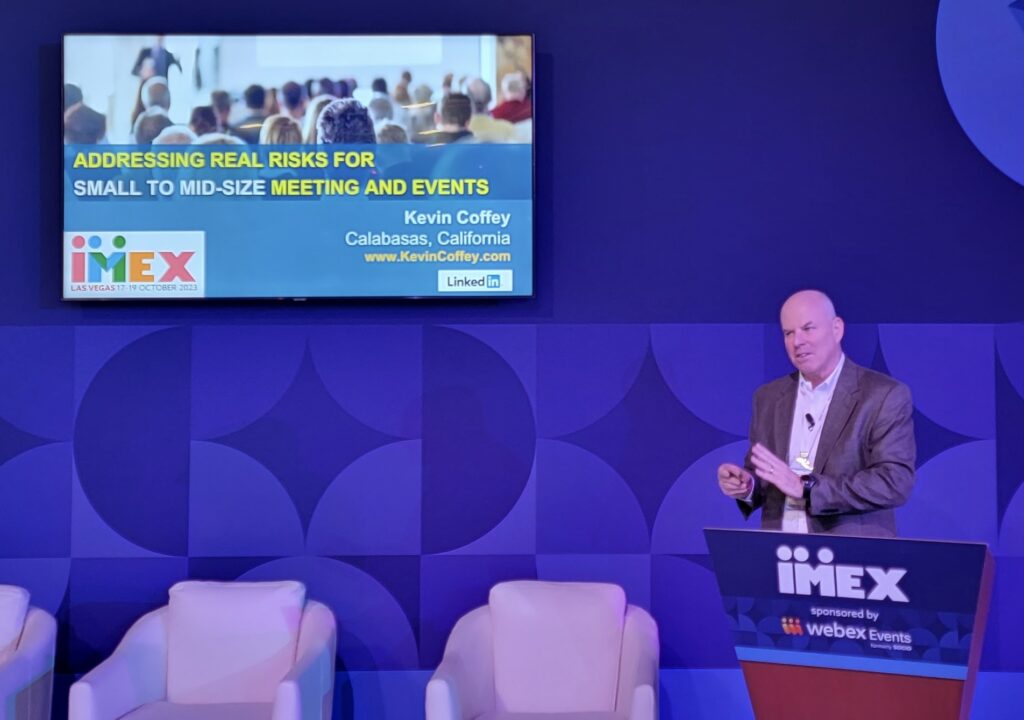Skift Take
Keeping attendees safe and secure is the focus of all meetings and conventions, but a rise in gun violence is making that more difficult.
“If not us, then who?” Al Hutchinson, president and CEO of Visit Baltimore, asks when discussing the issue of gun violence.
The number of incidents is staggering. As of the end of October, there have been 568 mass shootings in the U.S., according to Gun Violence Archive. It defines a mass shooting as an incident in which four or more people are injured or killed.
The latest took place in Maine, involving 18 casualties and 13 wounded. Robert Card, a U.S. Army reservist, is the accused perpetrator. This was the worst mass shooting in the U.S. since 2022, when 19 children and two teachers perished at Robb Elementary School in Uvalde, Texas.
Meeting Destinations Not Immune
Meeting destinations are not immune to such violence. Take Las Vegas, one of the top destinations in the U.S. for trade shows and conventions. It is the site of a deadly attack. Stephen Paddock opened fire on 22,000 concertgoers at the Route 91 Harvest music festival in 2017. He fired more than 1,000 rounds from his 32nd-floor suite in Mandalay Bay Resort & Casino. Fifty-eight people were killed and 500 wounded.
“Assailants have touched movie theaters, parks, theme parks, and schools. Wherever people gather — concerts, festivals — is an attractive target to those compelled by mental illness or other reasons to commit acts of heinous violence. We see this every day in our news. It’s real. It can happen anywhere. To any size convention, in any city. It’s got to be job one for us going forward to figure out,” said Gary LaBranche, CEO of the Risk and Insurance Management Society (RIMS), whose own conference was impacted by a shooting.
Gun violence is a public health epidemic in the U.S. So much so that President Joe Biden recently created the first-ever White House Office of Gun Violence Prevention.
Gun Violence Makes International Visitors Wary
International travel is suffering. An International Travel Agent/Advisor Survey by Tourism Academy reports that a whopping 94.1% of international visitors are more likely to choose destinations perceived as safer than the U.S. due to violence-related concerns.
Amnesty International has a travel advisory for the U.S. It advises people to have a contingency plan in place due to high levels of gun violence. In addition, countries including Canada, Australia, New Zealand, France, and the UK have issued warnings about visiting the U.S. due to high crime and firearm violence.
But gun violence isn’t just contained to the U.S. A Tunisian gunman killed two Swedish football fans in Brussels. The shooting came at a time of heightened security across much of Europe. This is because of the Israel-Hamas conflict. Belgium’s Euro 2024 qualifier against Sweden was canceled at half-time.
It’s not just guns that are a threat. This week, a bomb blast at the Zamra International Convention and Exhibition Centre in India killed three and wounded 50.
Riskworld Conference Closes Early Due to Shooting
In May, a fatal shooting in Atlanta forced RIMS to cancel the final day of its conference that included 9,000 global risk management professionals and 300 exhibitors. The shooting occurred about two and a half miles from the Georgia World Congress Center (GWCC).
LaBranche issued an emergency video statement informing that everyone at RiskWorld was safe but that the general session and closing party would be canceled. The assailant, who killed one and injured four, was still at large.
“Because of what happened to us, I’ve had the opportunity to have conversations with many others and learn about the violence that has impacted their conventions. This is a real danger. Something we need to take seriously as an industry,” said LaBranche.
RIMS More Prepared Than Most
As an association dedicated to advancing risk management, RIMS is prepared. In addition to a 73-page crisis plan, it had several advanced meetings with local law enforcement and the GWCC staff. Not only did they address safety, but the coinciding Taylor Swift concerts as well. Ironically, RIMS had done active shooter training three days before the incident.
“This is the kind of thing that can happen in any city to any size convention or event. We learned a lot that day. We had a 73-page crisis management plan. But most of it focused on the convention center itself,” says LaBranche. “From here on in, if we are having a citywide convention, we will have a citywide safety and security plan.” This was the most stressful four hours of his 42-year career, LaBranche admits. He is working on such a plan for next year’s convention set for San Diego in May.
Add Risk Manager to Your List of Responsibilities
“We are all risk managers now. My advice is to take that role and responsibility very seriously. It’s not a matter of if, it’s a matter of when something is going to happen,” said LaBranche. “You have to prepare for all threats, all hazards. It can’t just be theoretically on a piece of paper or in a file somewhere. You must have a clear plan in which your team knows its roles and responsibilities and practices them,” said LaBranche.
In Providence, RI, gun violence had a direct impact on a conference. Gunfire hit an out-of-town attendee while sitting in traffic in a rideshare. “It’s the kind of thing that can happen anywhere at any time,” says Kristen Adamo, president and CEO of the Providence Warwick CVB. The attendee has recovered. Not only is the group returning to Providence next year, but so is the attendee.
Focus on the What-Ifs

Kevin Coffey, a retired Los Angeles Police Department detective, is a travel safety and meeting risk trainer. He stresses that the industry needs to focus on meeting and event risk mitigation and response. This precedes DEI, sustainability, and everything else.
“I’ve typically found that many meeting and event professionals feel that in most circumstances meeting and event risk responsibilities fall to the hotel or facility security staff,” says Coffey.
A mistake. All what-if questions must be addressed. “This will help better understand how to better respond if an incident was to occur,” says Coffey.
Response Plan Vital
At the very least, a meeting professional needs a response plan. A risk checklist must address both pre-event and post-event procedures.
A few questions Coffey recommends meeting professionals ask before a meeting or event, no matter the size, include:
- Where are the emergency exits?
- Does the facility have automatic external defibrillators (AEDs) on-site? Where are they located? Coffey says it’s essential to remember that every minute counts in an emergency.
- Who is trained on AED use, and will they be on duty during your event?
- Have all emergency exits in the venue and areas surrounding it been checked by meeting staff to ensure an unobstructed exit before the meeting or event?
- Does every door of the venue you are meeting in have a map detailing emergency exists and a phone number to call for help? Coffey recommends mimicking what is on the back of hotel guest rooms.
In addition, active shooter training is a must. Furthermore, Meeting Professionals International (MPI) offers an Emergency Preparedness for Events Certificate program that focuses on the tools needed to plan for and respond to crises. MPI also offers a guide to safety and security.
Combatting Gun Violence Must be A Collaborative Effort
The Go Live Together coalition was launched during the pandemic to protect the live events industry. A coalition of 80 partners representing over 4,000 companies joined forces to support legislative actions to help the industry recover from the pandemic.
Industry insiders ask why a similar coalition can’t be created to combat gun violence. “We must come together as an industry and have a conversation. Recognize that this is an issue,” says Hutchinson. “From there, we must engage our local community, local stakeholders, state elected officials, and then federal leaders.”
The leading cause of death for children and teens is from firearms, he adds. “We need to do something. Our kids are getting killed, and they are on both sides of the political spectrum,” says Hutchinson.
PCMA, MPI, Destinations International, all the major hotel chains, and airlines — should start the conversation, says Hutchinson.
“This isn’t in our wheelhouse” is something he hears repeatedly. “It absolutely is. We must come together and do our part to make change with cool heads and calm hearts.”
RIMS is using its experience to help others. It is joining forces with the American Society for Association Executives (ASAE) and ASIS International, an association for security management professionals, to release a convention safety and risk management program and a toolkit next year. It will include tips, checklists, and tangible preparations and actions for risk management for event professionals.
“The industry needs to come together to have a serious conversation. We must create real tools and provide resources and guidelines to better protect the millions of participants in our face-to-face meetings,” says LaBranche.
Photo credit: Tsvetoslav Hristov / Unsplash





